在图片处理中,霍夫变换主要是用来检测图片中的几何形状,包括直线、圆、椭圆等。在skimage中,霍夫变换是放在tranform模块内。
一 霍夫线变换
对于平面中的一条直线,在笛卡尔坐标系中,可用y=mx+b来表示,其中m为斜率,b为截距。但是如果直线是一条垂直线,则m为无穷大,所有通常我们在另一坐标系中表示直线,即极坐标系下的r=xcos(theta)+ysin(theta)。即可用(r,theta)来表示一条直线。其中r为该直线到原点的距离,theta为该直线的垂线与x轴的夹角。如下图所示。
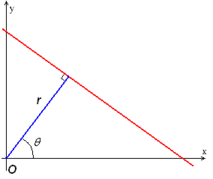
对于一个给定的点(x0,y0), 我们在极坐标下绘出所有通过它的直线(r,theta),将得到一条正弦曲线。如果将图片中的所有非0点的正弦曲线都绘制出来,则会存在一些交点。所有经过这个交点的正弦曲线,说明都拥有同样的(r,theta), 意味着这些点在一条直线上。
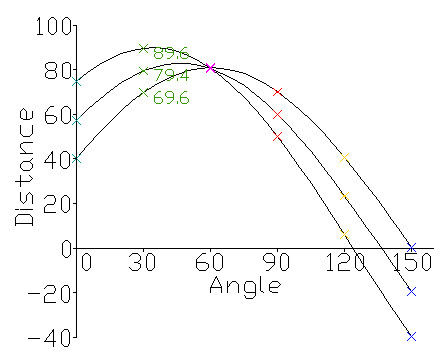
如上图所示,三个点(对应图中的三条正弦曲线)在一条直线上,因为这三个曲线交于一点,具有相同的(r, theta)。霍夫线变换就是利用这种方法来寻找图中的直线。
函数:skimage.transform.hough_line(img)
返回三个值:
- h: 霍夫变换累积器
- theta: 点与x轴的夹角集合,一般为0-179度
- distance: 点到原点的距离,即上面的所说的r.
import skimage.transform as st
import numpy as np
import matplotlib.pyplot as plt
# 构建测试图片
image = np.zeros((100, 100)) #背景图
idx = np.arange(25, 75) #25-74序列
image[idx[::-1], idx] = 255 # 线条
image[idx, idx] = 255 # 线条/
# hough线变换
h, theta, d = st.hough_line(image)
#生成一个一行两列的窗口(可显示两张图片).
fig, (ax0, ax1) = plt.subplots(1, 2, figsize=(8, 6))
plt.tight_layout()
#显示原始图片
ax0.imshow(image, plt.cm.gray)
ax0.set_title('Input image')
ax0.set_axis_off()
#显示hough变换所得数据
ax1.imshow(np.log(1 + h))
ax1.set_title('Hough transform')
ax1.set_xlabel('Angles (degrees)')
ax1.set_ylabel('Distance (pixels)')
ax1.axis('image')
结果如下图所示:
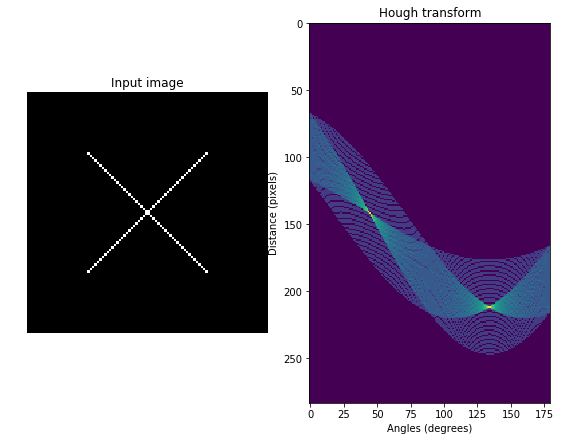
从右边那张图可以看出,有两个交点,说明原图像中有两条直线。如果我们要把图中的两条直线绘制出来,则需要用到另外一个函数:
skimage.transform.hough_line_peaks(hspace, angles, dists)
用这个函数可以取出峰值点,即交点,也即原图中的直线。返回的参数与输入的参数一样。我们修改一下上边的程序,在原图中将两直线绘制出来。
import skimage.transform as st
import numpy as np
import matplotlib.pyplot as plt
# 构建测试图片
image = np.zeros((100, 100)) #背景图
idx = np.arange(25, 75) #25-74序列
image[idx[::-1], idx] = 255 # 线条
image[idx, idx] = 255 # 线条/
# hough线变换
h, theta, d = st.hough_line(image)
#生成一个一行三列的窗口(可显示三张图片).
fig, (ax0, ax1,ax2) = plt.subplots(1, 3, figsize=(8, 6))
plt.tight_layout()
#显示原始图片
ax0.imshow(image, plt.cm.gray)
ax0.set_title('Input image')
ax0.set_axis_off()
#显示hough变换所得数据
ax1.imshow(np.log(1 + h))
ax1.set_title('Hough transform')
ax1.set_xlabel('Angles (degrees)')
ax1.set_ylabel('Distance (pixels)')
ax1.axis('image')
#显示检测出的线条
ax2.imshow(image, plt.cm.gray)
row1, col1 = image.shape
for _, angle, dist in zip(*st.hough_line_peaks(h, theta, d)):
y0 = (dist - 0 * np.cos(angle)) / np.sin(angle)
y1 = (dist - col1 * np.cos(angle)) / np.sin(angle)
ax2.plot((0, col1), (y0, y1), '-r')
ax2.axis((0, col1, row1, 0))
ax2.set_title('Detected lines')
ax2.set_axis_off()
结果如下图所示:
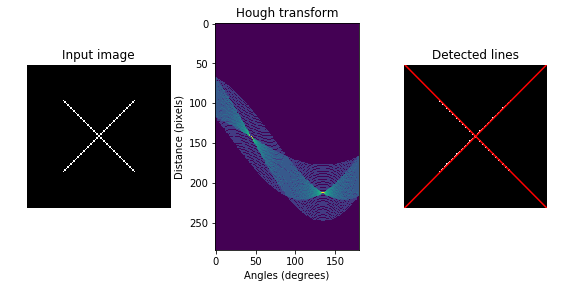
注意,绘制线条的时候,要从极坐标转换为笛卡尔坐标,公式为:

skimage还提供了另外一个检测直线的霍夫变换函数,概率霍夫线变换:
skimage.transform.probabilistic_hough_line(img, threshold=10, line_length=5,line_gap=3)
参数:
- img: 待检测的图像。
- threshold: 阈值,可先项,默认为10
- line_length: 检测的最短线条长度,默认为5
- line_gap: 线条间的最大间隙。增大这个值可以合并破碎的线条。默认为3
返回:
- lines: 线条列表, 格式如((x0, y0), (x1, y0)),标明开始点和结束点。
下面,我们用canny算子提取边缘,然后检测哪些边缘是直线?
import skimage.transform as st
import matplotlib.pyplot as plt
from skimage import data,feature,color
#使用Probabilistic Hough Transform.
image = data.camera()
edges = feature.canny(image, sigma=2, low_threshold=1, high_threshold=25)
lines = st.probabilistic_hough_line(edges, threshold=10, line_length=5,line_gap=3)
# 创建显示窗口.
fig, (ax0, ax1, ax2) = plt.subplots(1, 3, figsize=(16, 6))
plt.tight_layout()
#显示原图像
ax0.imshow(image, plt.cm.gray)
ax0.set_title('Input image')
ax0.set_axis_off()
#显示canny边缘
ax1.imshow(edges, plt.cm.gray)
ax1.set_title('Canny edges')
ax1.set_axis_off()
#用plot绘制出所有的直线
ax2.imshow(edges * 0)
for line in lines:
p0, p1 = line
ax2.plot((p0[0], p1[0]), (p0[1], p1[1]))
row2, col2 = image.shape
ax2.axis((0, col2, row2, 0))
ax2.set_title('Probabilistic Hough')
ax2.set_axis_off()
plt.show()
结果如下图所示:
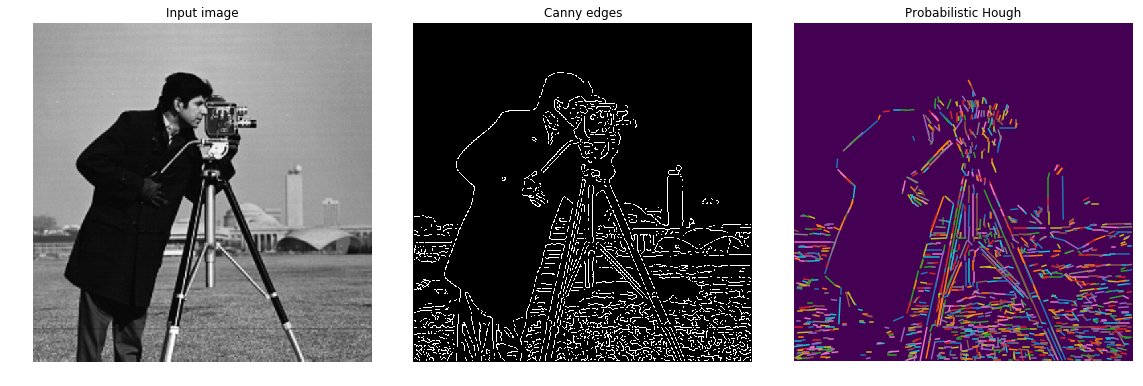
二 霍夫圆和椭圆变换
在极坐标中,圆的表示方式为:
- x=x0+rcosθ
- y=y0+rsinθ
圆心为(x0,y0),r为半径,θ为旋转度数,值范围为0-359
如果给定圆心点和半径,则其它点是否在圆上,我们就能检测出来了。在图像中,我们将每个非0像素点作为圆心点,以一定的半径进行检测,如果有一个点在圆上,我们就对这个圆心累加一次。如果检测到一个圆,那么这个圆心点就累加到最大,成为峰值。因此,在检测结果中,一个峰值点,就对应一个圆心点。
霍夫圆检测的函数:
skimage.transform.hough_circle(image, radius)
- radius是一个数组,表示半径的集合,如[3,4,5,6]
- 返回一个3维的数组(radius index, M, N), 第一维表示半径的索引,后面两维表示图像的尺寸。
例1:绘制两个圆形,用霍夫圆变换将它们检测出来。
import numpy as np
import matplotlib.pyplot as plt
from skimage import draw,transform,feature
img = np.zeros((250, 250,3), dtype=np.uint8)
rr, cc = draw.circle_perimeter(60, 60, 50) #以圆心为(60,60)半径为50画一个圆,
rr1, cc1 = draw.circle_perimeter(150, 150, 60) #以圆心为(150,150)半径为60画一个圆
img[cc, rr,:] =255
img[cc1, rr1,:] =255
fig, (ax0,ax1) = plt.subplots(1,2, figsize=(8, 5))
ax0.imshow(img) #显示原图
ax0.set_title('origin image')
hough_radii = np.arange(50, 80, 5) #半径范围
hough_res =transform.hough_circle(img[:,:,0], hough_radii) #圆变换
centers = [] #保存所有圆心点坐标
accums = [] #累积值
radii = [] #半径
for radius, h in zip(hough_radii, hough_res):
#每一个半径值,取出其中两个圆
#zip()的用法
num_peaks = 2
peaks =feature.peak_local_max(h, num_peaks=num_peaks) #取出峰值
centers.extend(peaks)
accums.extend(h[peaks[:, 0], peaks[:, 1]])
radii.extend([radius] * num_peaks)
#画出最接近的圆
image =np.copy(img)
for idx in np.argsort(accums)[::-1][:2]:#argsort()函数是将x中的元素从小到大排列,提取其对应的index(索引),然后输出到y
center_x, center_y = centers[idx]
radius = radii[idx]
cx, cy =draw.circle_perimeter(center_y, center_x, radius)
image[cy, cx] =(255,0,0)
ax1.imshow(image)
ax1.set_title('detected image')
结果如下图所示:
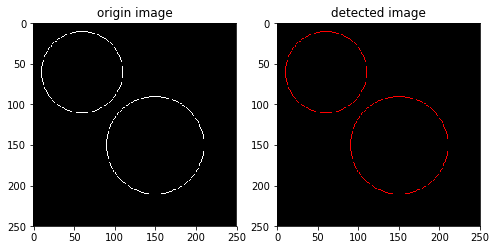
例2,检测出下图中存在的硬币。

import numpy as np
import matplotlib.pyplot as plt
from skimage import data, color,draw,transform,feature,util
image = util.img_as_ubyte(data.coins()[0:95, 70:370]) #裁剪原图片
edges =feature.canny(image, sigma=3, low_threshold=10, high_threshold=50) #检测canny边缘
fig, (ax0,ax1) = plt.subplots(1,2, figsize=(8, 5))
ax0.imshow(edges, cmap=plt.cm.gray) #显示canny边缘
ax0.set_title('original iamge')
hough_radii = np.arange(15, 30, 2) #半径范围
hough_res =transform.hough_circle(edges, hough_radii) #圆变换
centers = [] #保存中心点坐标
accums = [] #累积值
radii = [] #半径
for radius, h in zip(hough_radii, hough_res):
#每一个半径值,取出其中两个圆
num_peaks = 2
peaks =feature.peak_local_max(h, num_peaks=num_peaks) #取出峰值
centers.extend(peaks)
accums.extend(h[peaks[:, 0], peaks[:, 1]])
radii.extend([radius] * num_peaks)
#画出最接近的5个圆
image = color.gray2rgb(image)
for idx in np.argsort(accums)[::-1][:5]:
center_x, center_y = centers[idx]
radius = radii[idx]
cx, cy =draw.circle_perimeter(center_y, center_x, radius)
image[cy, cx] = (255,0,0)
ax1.imshow(image)
ax1.set_title('detected image')
结果如下图所示:

椭圆变换是类似的,使用函数为:
skimage.transform.hough_ellipse(img,accuracy, threshold, min_size, max_size)
输入参数:
- img: 待检测图像。
- accuracy: 使用在累加器上的短轴二进制尺寸,是一个double型的值,默认为1
- thresh: 累加器阈值,默认为4
- min_size: 长轴最小长度,默认为4
- max_size: 短轴最大长度,默认为None,表示图片最短边的一半。
返回一个 [(accumulator, y0, x0, a, b, orientation)] 数组。
- accumulator表示累加器
- (y0,x0)表示椭圆中心点
- (a,b)分别表示长短轴,orientation表示椭圆方向
例:检测出咖啡图片中的椭圆杯口。
import matplotlib.pyplot as plt
from skimage import data,draw,color,transform,feature
#加载图片,转换成灰度图并检测边缘
image_rgb = data.coffee()[0:220, 160:420] #裁剪原图像,不然速度非常慢
image_gray = color.rgb2gray(image_rgb)
edges = feature.canny(image_gray, sigma=2.0, low_threshold=0.55, high_threshold=0.8)
#执行椭圆变换
result =transform.hough_ellipse(edges, accuracy=20, threshold=250,min_size=100, max_size=120)
result.sort(order='accumulator') #根据累加器排序
#估计椭圆参数
best = list(result[-1]) #排完序后取最后一个
yc, xc, a, b = [int(round(x)) for x in best[1:5]]
orientation = best[5]
#在原图上画出椭圆
cy, cx =draw.ellipse_perimeter(yc, xc, a, b, orientation)
image_rgb[cy, cx,:] = (255, 0, 0) #在原图中用蓝色表示检测出的椭圆
fig2, (ax1, ax2) = plt.subplots(ncols=2, nrows=1, figsize=(8, 4))
ax1.set_title('canny')
ax1.imshow(edges)
ax2.set_title('result')
ax2.imshow(image_rgb)
plt.show()
结果如下图所示:
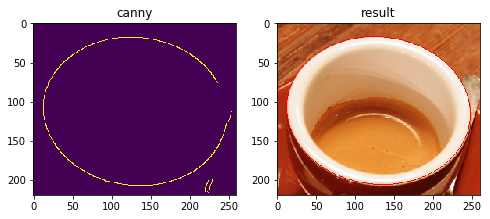
霍夫椭圆变换速度非常慢,应避免图像太大。